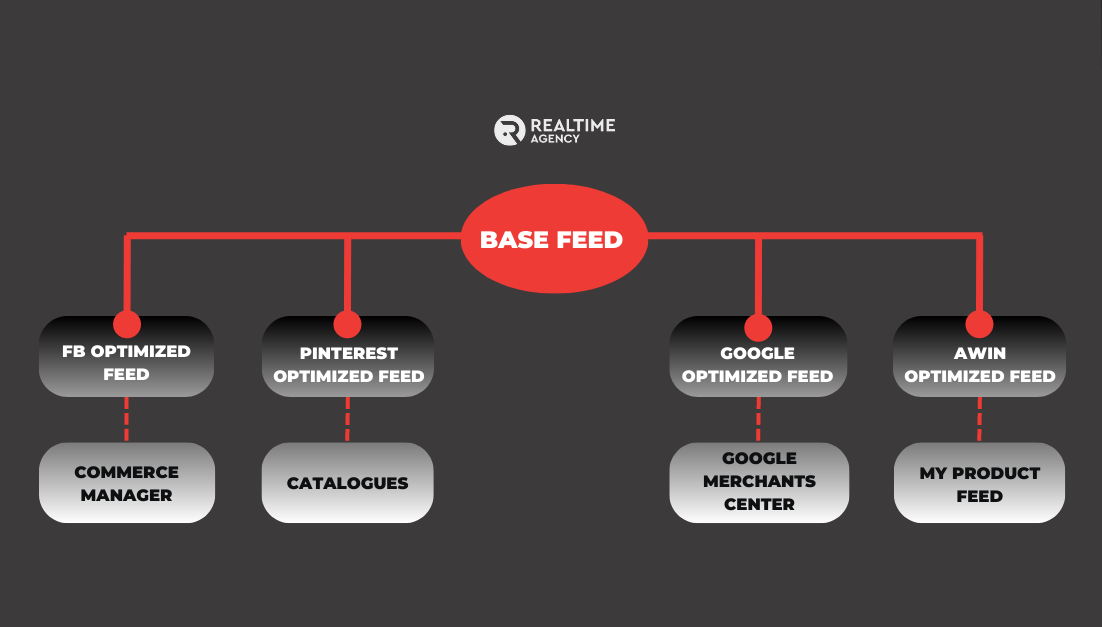While most e-commerce advertisers are familiar with product feeds, we tend to find that many of them have not cracked the code to make their feeds work as hard as possible for their advertising.
If this sounds like you – don’t fret; in this article, we’ll explain what product feeds are, the breadth of their capabilities, and how you can be using shopping feed optimization to boost your campaigns.
Product feeds are a way of sending information about your products to marketing platforms, which can then be grouped in any way that is helpful for your business. The information that gets passed to ad platforms includes attributes such as product title, image, price, item category, and more.

Inventory
One of the primary functions of a product feed is to ensure that the products you’re selling are shown accurately. By integrating with your inventory system, the product feed ensures that the information about product availability is accurate and up to date across all platforms. This real-time synchronization is essential for providing a seamless shopping experience to customers. When a product is out of stock, the feed can automatically update the information on all channels, preventing customers from being shown products that can’t be purchased due to selling out/ being unavailable. This saves you valuable ad spend that would be spent otherwise on an unavailable item.
Tailored Customer Experience
In addition to stock management, product feeds also facilitate customization and personalization in the online shopping experience. They allow you to include detailed and structured information about each product, such as product titles, descriptions, prices, images, variations, and other attributes. This rich data enables marketers and advertisers to optimize product listings for different platforms, making them more relevant and appealing to specific target audiences.
With a well-structured product feed, you can customize your product listings based on various factors, such as location, device type, or user preferences. For example, you can display different images or descriptions for the same product depending on whether a customer is being served ads on a Google Search, an Instagram shopfront or as part of a display campaign. This level of customization enhances the user experience and increases the likelihood of conversions.
Regional Control
With many modern ecommerce businesses selling products in multiple regions, there is a distinct need to tailor your shopping feed to different regions. This includes critical information such as different currency pricing, shipping costs, and different stock in different regions but also includes detail-oriented information such as translated product names, descriptions and even regional sizing. By building region specific product feeds you have control over how your product feed based ads appear in different regions, giving you accurate representation of your products globally and giving you the best chance of incremental sales and a higher return on ad spend.
Product feeds allow you to display your product images and their pricing across multiple advertising platforms. This in itself increases ecommerce businesses’ ability to advertise and make sales.
However, there are a number of additional benefits that a product feed provides. The opportunity to leverage advanced shopping campaigns & placements across various platforms, including Google, Facebook, Instagram, TikTok, Pinterest, and affiliate platforms.
Google Shopping & PMAX Campaigns
Product feeds provide access to powerful search shopping campaigns and PMAX campaigns. Smart shopping campaigns on google enable businesses to showcase their products directly in search engine results, increasing visibility and driving targeted traffic. PMAX campaigns, on the other hand, allow for automated bidding and optimization across Google’s suite of products (display, Youtube, Shopping & Search) maximizing the performance of product ads and driving higher returns. In order for these to function well, you need to ensure your product feed is present and in top shape.
Dynamic Retargeting Campaigns
By connecting with conversions APIs or pixel data, product feeds enable special e-commerce product placements such as dynamic retargeting and retargeting from programmatic advertising. These advanced campaigns can significantly enhance the return on ad spend (ROAS) for businesses, by tracking users that view a specific product and linking that user to the product. This opens the door for an advertiser to use dynamic ads to retarget a user with the item(s) that they’ve viewed online.
Ecommerce Focused Ad Placements
Additionally, by using a product feed, advertisers can use more intelligent ad products. For example, with catalog ads, businesses can showcase their best items and create visually appealing advertisements that attract and engage potential customers. By presenting a curated selection of products through integrated shopfronts on platforms like Instagram and TikTok, businesses can tap into organic reach and expose their products to a wider audience.
Customizable Ad Placements / Dynamic Product Images
Once your product feed is ingested into an at platform, some platforms such as Meta also allow for the creation of dynamic product images, which add personalized and dynamic elements to ads. This includes adding sale labels, best seller tags, or other custom attributes that resonate with the target audience. By incorporating these dynamic elements, businesses can increase click-through rates (CTR) and ultimately sales.
Product Sets
Furthermore, product feeds enable businesses to create bespoke product groups for campaigns focused on selling specific items. This level of granularity allows for precise targeting and optimization, ensuring that the right products are presented to the right audiences, increasing the chances of conversions.
To learn more about how to get the most out of your product feed, please see our handy 11 point guide.
Product feed management takes dedicated resources in order to develop and maintain strategy that makes all of the above benefits possible. Brands have a few different ways to do this, each with their own advantages and hurdles.
Option 1: In-house team
An in-house team will of course have the deepest level of knowledge of your brand, products, and target audience. Additionally, they’ll have direct access to internal resources and can collaborate closely with other departments, such as marketing or inventory management, to ensure accurate information is reflected in the product feed. This sort of familiarity enables much quicker decision making and collaboration.
However, an in-house team may come with expertise restraints and scalability challenges. Building and maintaining an in-house team dedicated to managing product feeds requires significant resources. It involves hiring and training personnel with the necessary technical skills and domain expertise. Additionally, staying updated with the evolving e-commerce landscape, industry best practices, and emerging technologies can be challenging for an in-house team, especially for smaller brands with limited resources. Because of this, the workload associated with managing product feeds can quickly become a very heavy burden for inexperienced in-house teams, especially as the company grows. This scalability issue can lead to bottlenecks and potential delays in adapting the product feed to new requirements.
Option 2: APIs
If you’re lucky enough to be using one of the big ecommerce platforms like Shopify or Woocommerce, API connections may be the best solution for you. Due to the huge popularity of these ecommerce platforms, ad platforms like Meta, TikTok & Pinterest often offer ‘1-click’ integration between your ad platform and your commerce platform.
By integrating the API with the brand’s inventory system or database, product data can be automatically synchronized and updated in real-time. This automation eliminates the need for manual data entry and reduces the chances of errors or inconsistencies. It saves time, improves operational efficiency, and ensures that product information is always up to date. This also means scalability is not an issue, and updating large volumes of products within the feed is quick and easy.
Brands can leverage this integration to distribute their product listings to multiple channels simultaneously, reaching a broader audience and increasing their online visibility. This facilitation of omnichannel marketing allows for centralized management of product information across different platforms.
But, APIs also come with disadvantages. Managing your product feed is only ‘quick and easy’ if the API integration is managed by someone familiar with the technical complexity. This can pose challenges for brands that lack the required skills or resources, especially smaller businesses with limited IT capabilities. You’ll also find significantly less customization capabilities with APIs. Brands may not have full control over the structure or format of the product feed, as it is governed by the API provider’s specifications, which can make it extremely challenging for brands to customize the feed to align with specific branding or marketing requirements.
Option 3: Software
You may also be considering a data feed software partner to manage your product feed. Much like an API partner, software partners offer a huge benefit with scalability as they typically have extensive knowledge and experience in the field. By being equipped to handle complex feed management tasks, optimize product listings, and stay updated with the latest industry trends and best practices, software partners can save brands a lot of time, and cut down on used resources. Additionally, most data feed management software companies will have access to advanced features and tools, which may include tech for data optimization, feed customization, performance tracking, analytics, or reporting.
One of the challenges with working with a software partner is that they will still require a significant time investment and a considerable amount of expertise. If using a self-serve software, you will have access to tools to customize your product feed without the need for developer support, but you will still have to invest time into making these changes. Platforms offer rule-based customization to increase efficiency, but depending on the size of your product range, you could still be looking at 100’s of hours of time to make sure your feed fits best practice.
However, if you are working with a full-service partner, you won’t have to get your hands dirty.
But, one of the largest considerations here will be cost. Typically, you may be looking at paying more for this type of partner especially if you’re looking to take advantage of their managed services (ie. expertise), as you’ll usually be paying separate fees for managed services and software. The good thing with full-service is that you won’t have to spend hours doing the technical work, you simply tell them what you need and they build it. However, you will be at the mercy of their specified time-frames as functionally you don’t see much of the backend processes.
Option 4: Ad Agencies
Advertising agencies are also a fantastic option for managing your product feeds and making them work harder. Because ad agencies specialize in marketing strategies, including e-commerce platforms, they can provide valuable insights and recommendations for maximizing the visibility and performance of product data optimization. Additionally, many agencies will have creative and design capabilities that can help to create compelling product descriptions, engaging visuals, and persuasive copy that aligns with the brand’s messaging and target audience, and improves the attractiveness of product feeds. Additionally, ad agencies typically have access to a wide range of marketing tools, technologies, and have established relationships with various ad platforms. These resources can aid in optimizing product feeds, analyzing performance data, and identifying opportunities for improvement. All of this can save brands a tremendous amount of time and money.
If you’re working with a larger agency, you may lose a significant amount of control over customization, but if you decide to work with an independent agency (like Realtime! Email us for more info: tyler@realtimeagency.com), you’re more likely to have a team who is able to accommodate customization requests. Additionally, as with any external agency, there’s room for potential communication challenges, and effective communication and collaboration between the brand and the advertising agency are vital for successful product feed management.
No matter which option you choose, product feed management is critical for your e-comm business to master if you want to improve costs in a scalable way. Contact us to learn more about how to make your product feed work for you, and explore if an agency could help alleviate your workload while saving costs.
Share this post

Guy James
VP, Growth & Marketing
Share